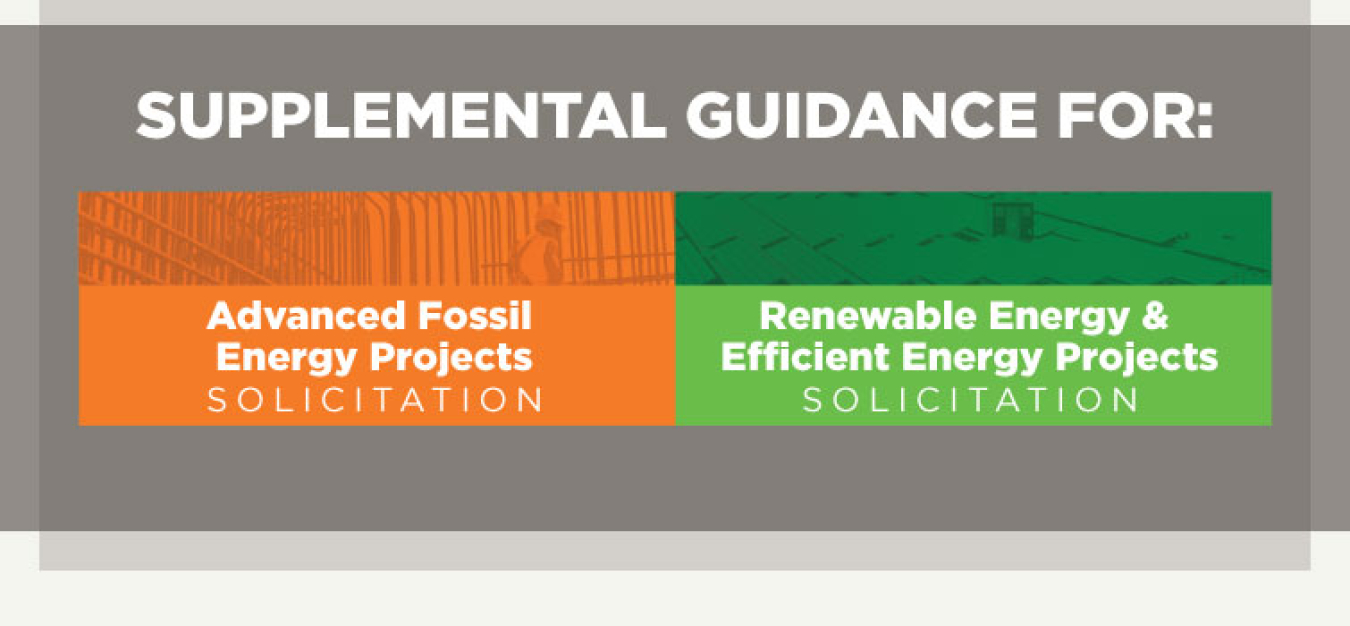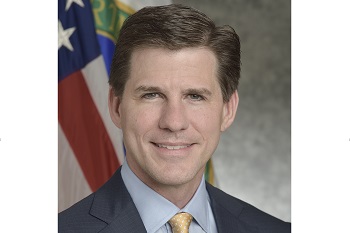The Department of Energy's Loan Programs Office announced that $1 billion of additional loan guarantee authority has been finalized and application deadlines have been extended for the Advanced Fossil Energy Projects and Renewable Energy and Efficient ...
Office of Energy Dominance Financing
October 21, 2015
This afternoon, Secretary Moniz made two announcements at the Climate and Clean Energy Investment Forum in Washington, DC about ways in which the Loan Programs Office (LPO) will continue its efforts to finance innovative clean energy technologies.
The first announcement was related to the $1 billion of additional loan guarantee authority that President Obama announced in August. The 45-day congressional notification period required for allocating this money has concluded and with the supplemental guidance posted on LPO’s website today, that loan guarantee authority is now available for applicants. The supplemental guidance for the Advanced Fossil Energy Projects solicitation adds $500 million, raising the total available to up to $8.5 billion. The supplemental guidance for the Renewable Energy and Efficient Energy (REEE) Projects solicitation also adds $500 million, raising the total to approximately $4.5 billion ($3 billion in loan guarantee authority, plus an additional amount that can be imputed based on the availability of an appropriation for the credit subsidy cost of such imputed loan guarantee authority. The amount of total loan guarantee authority available pursuant to the Solicitation will depend on credit subsidy rates.).
At that same event in August, the President made a separate announcement to clarify that Distributed Energy Projects are eligible for loan guarantees under the Advanced Fossil Energy and REEE solicitations. Distributed energy projects are driving innovation in U.S. energy markets and the announcement clarified the types of projects and financial structures that LPO could support under its existing solicitations.
We have been very pleased about the positive response we have received following this announcements and the overall pipeline of projects that have applied to date. That is why the Secretary also announced today that the supplemental guidances issued today by LPO also add new rounds of Part I and Part II application deadlines for the Advanced Fossil and REEE solicitations that extend well into 2016.
Upcoming Part I Application Deadlines
- 11/18/2015
- 12/30/2015
- 1/13/2016
- 3/16/2016
- 5/18/2016
- 7/13/2016
Upcoming Part II Application Deadlines
- 12/16/2015
- 2/17/2016
- 4/13/2016
- 6/15/2016
- 8/17/2016
- 10/19/2016
We hope these announcements continue to encourage innovative clean energy projects to apply for Title XVII loan guarantees and we look forward to doing more deals in the future.
Title XVII Open Solicitations
INNOVATIVE ENERGY AND INNOVATIVE SUPPLY CHAIN
Title 17 Clean Energy Financing – Innovative Energy and Innovative Supply Chain
Financing for projects that:
Deploy innovative clean energy technologies at commercial scale (Innovative Energy)
Or
Employ innovative manufacturing processes or manufacture innovative technologies at commercial scale (Innovative Supply Chain)
Overview
Through the Innovative categories of the Title 17 Clean Energy Financing Program, LPO can finance projects that deploy new or significantly improved high-impact clean energy technology (Innovative Energy) or that employ new or significantly improved technology in the manufacturing process for a qualifying clean energy technology or manufacture innovative products with an eligible technology end-use (Innovative Supply Chain).
LPO-financed projects show private debt and equity investors that innovative clean energy technologies are bankable and ready for large-scale deployment. LPO has a strong track record of catalyzing clean energy deployment, having financed the first utility-scale photovoltaic solar projects in the United States, one of the world’s largest wind projects, the next generation of advanced nuclear reactors, and the nation’s first clean hydrogen energy and storage project.
Like commercial lenders and other private capital market lenders, LPO underwrites loans with the expectation that they will be repaid with interest. Unlike most lenders, LPO has in-house technical experts who work with applicants to understand the project’s true technical risks. From there, LPO’s credit, market, environmental, and legal professionals work with applicants to structure loan terms accordingly. The result is often access to lower-interest loans than would otherwise be available. The early deployments LPO finances de-risk follow-on deployments.
LPO engages early with applicants and offers flexible financing that private lenders typically do not provide for projects developing innovative components for the low-carbon supply chain. By doing so, LPO can jumpstart production and minimize future supply chain bottlenecks for innovative clean energy technologies.
Defining “Innovative”
LPO considers projects innovative if they employ a New or Significantly Improved Technology. (See page 15 of the Program Guidance or the Title 17 Interim Final Rule for a definition of New or Significantly Improved Technology.)
New or Significantly Improved Technology refers to technologies concerned with the production, consumption, storage, or transportation of energy, including of associated critical minerals and other components or other eligible energy-related project categories, and that is not a commercial technology, and that either:
- Has only recently been developed, discovered, or learned; or
- Involves or constitutes one or more meaningful and important improvements in productivity or value, in comparison to commercial technologies used in the United States.
When evaluating whether a technology is “New or Significantly Improved,” LPO will consider whether the technology could have a catalytic effect on the market and whether the technology has the potential to be employed in other commercial projects.
Eligibility
In addition to the common eligibility requirements that apply to all Title 17 Clean Energy Financing Program projects, Innovative Energy and Innovative Supply Chain projects must meet several additional eligibility criteria.
All Innovative projects must align with one of the following eligible technologies:
- Advanced nuclear energy
- Efficient electrical generation, transmission, and distribution
- Supply of critical minerals
- Carbon capture and sequestration technologies
- Advanced fossil energy technology
- Oil refineries
- Energy storage technologies
- Production facilities for the manufacture of fuel-efficient vehicles or parts of those vehicles
- Renewable energy systems
- Industrial decarbonization technologies
- Hydrogen fuel cell technology
- Pollution control equipment
- Efficient end-use energy technologies
Innovative Energy-Specific Requirements
- Projects must include a New or Significantly Improved Technology applied to one or more of the eligible technologies.
Innovative Supply Chain-Specific Requirements
-
Projects must either employ a New or Significantly Improved Technology in the manufacturing process for an eligible technology or manufacture a component that represents an eligible New or Significantly Improved Technology.
-
Projects must avoid, reduce, utilize, or sequester air pollutants or anthropogenic emissions of greenhouse gases through (1) the manufacturing process of the relevant product or (2) the end-use of the component on a full life-cycle basis.
Possible Project Areas
The following is a set of project types that could be eligible for Innovative Energy financing, subject to LPO review. These examples are neither exhaustive nor limiting.
The following is a set of project types that could be eligible for Innovative Energy financing, subject to LPO review. These examples are neither exhaustive nor limiting.
- Distributed solar and storage (virtual power plant)
- Distributed demand response (virtual power plant)
- Offshore wind
- Stationary and/or mobile energy storage
- HVDC transmission
- Small modular reactor (SMR) nuclear
- "Front-end" nuclear fuel cycle
- Advanced nuclear reactors
- Nuclear uprates or upgrades
- Advanced geothermal
- Carbon capture, utilization, and storage (CCUS)
- Hydrogen production and infrastructure
- Sustainable aviation fuels, biofuels
- Alternative vehicle fuel distribution facilities (e.g., hydrogen, LNG, CNG)
The following is a set of project types that could be eligible for Innovative Supply Chain financing, subject to LPO review. These examples are neither exhaustive nor limiting.
- Solar supply chain components
- Low-carbon cement, steel, or iron
- Onshore and/or offshore wind components
- Small modular reactors and micro reactors
- Advanced nuclear components
- Critical minerals (including processing, manufacturing, and recycling of mineral alternatives)
- Electric vehicle charging infrastructure
- Electric grid components
- Low-carbon pulp and paper
- Low-carbon chemicals
- Low-carbon aluminum
- Electrolyzer manufacturing
Additional program details and application requirements are described in the Title 17 Clean Energy Financing Program Guidance and on the Title 17 Overview web page.
Next Steps
If you have a project that may be eligible for financing through the Innovative Energy or Innovative Supply Chain project categories, please request a no-cost pre-application consultation.


